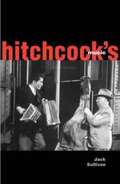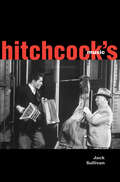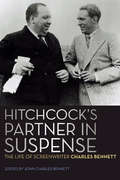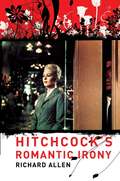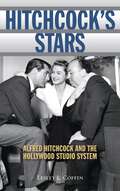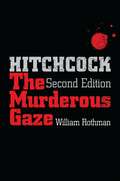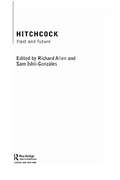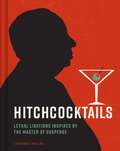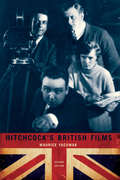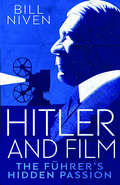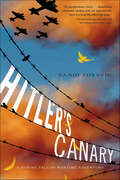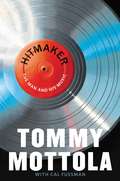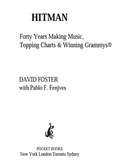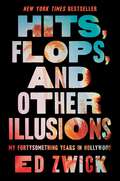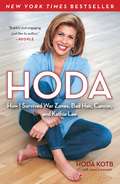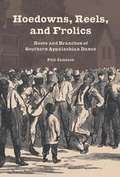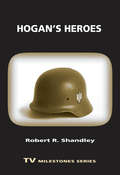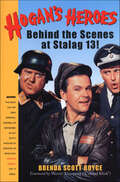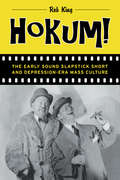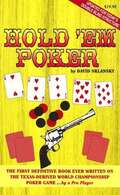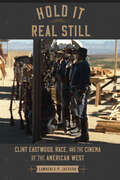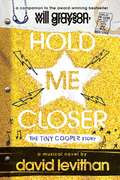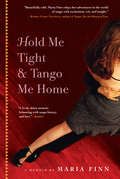- Table View
- List View
Hitchcock's Music
by Jack SullivanFor half a century Alfred Hitchcock created films full of gripping and memorable music. Over his long career he presided over more musical styles than any director in history and ultimately changed how we think about film music. This book is the first to fully explore the essential role music played in the movies of Alfred Hitchcock. Based on extensive interviews with composers, writers, and actors, and research in rare archives, Jack Sullivan discusses how Hitchcock used music to influence the atmosphere, characterization, and even storylines of his films. Sullivan examines the director's important relationships with various composers, especially Bernard Herrmann, and tells the stories behind the musical decisions. Covering the whole of the director's career, from the early British works up to Family Plot, this engaging look at the work of Alfred Hitchcock offers new insight into his achievement and genius and changes the way we watch-and listen-to his movies.
Hitchcock's Music
by Jack Sullivan"A wonderfully coherent, comprehensive, groundbreaking, and thoroughly engaging study&” of how the director of Psycho and The Birds used music in his films (Sidney Gottlieb, editor of Hitchcock on Hitchcock). Alfred Hitchcock employed more musical styles and techniques than any film director in history, from Marlene Dietrich singing Cole Porter in Stage Fright to the revolutionary electronic soundtrack of The Birds. Many of his films—including Notorious, Rear Window, Vertigo, North by Northwest, and Psycho—are landmarks in the history of film music. Now author and musicologist Jack Sullivan presents the first in-depth study of the role music plays in Hitchcock&’s films. Based on extensive interviews with composers, writers, and actors, as well as archival research, Sullivan discusses how Hitchcock used music to influence his cinematic atmospheres, characterizations, and even storylines. Sullivan examines the director&’s relationships with various composers, especially Bernard Herrmann, and tells the stories behind some of their now-iconic musical choices. Covering the entire director&’s career, from the early British works up to Family Plot, this engaging work will change the way we watch—and listen—to Hitchcock&’s movies.
Hitchcock's Partner in Suspense: The Life of Screenwriter Charles Bennett (Screen Classics)
by Charles BennettThe colorful life and creative career of the writer behind six of Hitchcock&’s thrillers: &“An intriguing and revealing story.&” —Times Literary Supplement With a career that spanned from the silent era to the 1990s, British screenwriter Charles Bennett lived an extraordinary life. His experiences as an actor, director, playwright, film and television writer, and novelist in both England and Hollywood left him with many amusing anecdotes, opinions about his craft, and impressions of the many famous people he knew. Among other things, Bennett was a decorated WWI hero, an eminent Shakespearean actor, and an Allied spy and propagandist during WWII, but he is best remembered for his commercially and critically acclaimed collaborations with directors Sir Alfred Hitchcock and Cecil B. DeMille. The fruitful partnership with Hitchcock began after the director adapted Bennett&’s 1929 play Blackmail as the first British sound film. Their partnership produced six thrillers: The Man Who Knew Too Much, The 39 Steps, Sabotage, Secret Agent, Young and Innocent, and Foreign Correspondent. In this witty and intriguing book, Bennett discusses how their collaboration created such famous motifs as the &“wrong man accused&” device and the MacGuffin. He also takes readers behind the scenes with the Master of Suspense, offering his thoughts on the director&’s work, sense of humor, and personal life. Featuring an introduction and additional biographical material from Bennett&’s son, editor John Charles Bennett, Hitchcock&’s Partner in Suspense is a richly detailed narrative of a remarkable yet often-overlooked figure in film history.
Hitchcock's Romantic Irony
by Richard AllenIn a new interpretation of the director's work, Richard Allen argues that Hitchcock orchestrates the narrative and stylistic idioms of popular cinema to at once celebrate and subvert the ideal of romance and to forge a distinctive worldview-the amoral outlook of the romantic ironist or aesthete.
Hitchcock's Romantic Irony (Film and Culture Series)
by Richard AllenIs Hitchcock a superficial, though brilliant, entertainer or a moralist? Do his films celebrate the ideal of romantic love or subvert it? In a new interpretation of the director's work, Richard Allen argues that Hitchcock orchestrates the narrative and stylistic idioms of popular cinema to at once celebrate and subvert the ideal of romance and to forge a distinctive worldview-the amoral outlook of the romantic ironist or aesthete. He describes in detail how Hitchcock's characteristic tone is achieved through a titillating combination of suspense and black humor that subverts the moral framework of the romantic thriller, and a meticulous approach to visual style that articulates the lure of human perversity even as the ideal of romance is being deliriously affirmed. Discussing more than thirty films from the director's English and American periods, Allen explores the filmmaker's adoption of the idioms of late romanticism, his orchestration of narrative point of view and suspense, and his distinctive visual strategies of aestheticism and expressionism and surrealism.
Hitchcock's Stars: Alfred Hitchcock and the Hollywood Studio System
by Lesley L CoffinAlthough he was a visual stylist who once referred to actors as cattle, Alfred Hitchcock also had a remarkable talent for innovative and creative casting choices. The director launched the careers of several actors and completely changed the trajectory of others, many of whom created some of the most iconic screen performances in history. However, Hitchcock’s ability to fit his leading men and women into just the right parts has been a largely overlooked aspect of his filmmaking skills. In Hitchcock’s Stars: Alfred Hitchcock and the Hollywood Studio System, Lesley L. Coffin looks at how the director made the most of the actors who were at his disposal for several decades. From his first American production in 1940 to his final feature in 1976, Hitchcock’s films were examples of creative casting that strayed far from the norm during the structured Hollywood star system. Rather than examining the cinematic aspects of his work, this book explores the collaboration the director engaged in with some of the most
Hitchcock, Second Edition: The Murderous Gaze (SUNY series, Horizons of Cinema)
by William RothmanFirst published in 1982, William Rothman's Hitchcock is a classic work of film criticism. Written in an engaging style that is philosophically sophisticated yet free of jargon, and using over nine hundred images from the films to illustrate and back up its critical claims, the book follows six different Hitchcock films as they unfold, moment by moment, from first shot to last.In addition to a thoughtful new preface and the original readings of The Lodger (1927), Murder! (1930), The 39 Steps (1935), Shadow of a Doubt (1943), and Psycho (1960), this expanded edition includes a groundbreaking new chapter—now the book's longest—on Marnie (1964), Hitchcock's most heartfelt yet most controversial film. Hitchcock never tired of quoting Oscar Wilde's line, "And all men kill the thing they love." Dark moods therefore prevail in the five original chapters, culminating in the reading of Psycho, but in demonstrating how Marnie overcomes, or transcends, the murderous aspect of Hitchcock's art, this new chapter balances the scales and gives an important new dimension to the book.With exemplary precision, Hitchcock, Second Edition shows how Hitchcock films express, cinematically, serious thoughts about such matters as the nature and relationships of love, murder, sexuality, marriage, and theater—and about their own medium. In so doing, it keeps faith with the idea that Hitchcock was a master, perhaps the master, of what he called the "art of pure cinema." However, insofar as it investigates philosophically the conditions of authorship in the medium of film, it is an auteurist study unlike any other. By attending to the films themselves and to the ways we experience them, rather than allowing some theory to dictate what to say about them, the book proves the fruitfulness of an approach that is open and responsive to the ways serious films are capable of teaching us how to think seriously about them.
Hitchcock: Past and Future
by Richard Allen Sam Ishii-GonzálesThis new collection of writings on Alfred Hitchcock considers Hitchcock both in his time and as a continuing influence on filmmakers, films and film theory. The contributions, who include leading scholars such as Slavoj Zizek, Laura Mulvey, Peter Wollen, and James Naremore, discuss canonical films such as Notorious and The Birds alongside lesser-known works including Juno and the Paycock and Frenzy. Articles are grouped into four thematic sections: 'Authorship and Aesthetics' examines Hitchcock as auteur and investigates central topics in Hitchcockian aesthetics. 'French Hitchcock' looks at Hitchcock's influence on filmmakers such as Chabrol, Truffaut and Rohmer, and how film critics such as Bazin and Deleuze have engaged with Hitchcock's work. 'Poetics and Politics of Identity' explores the representation of personal and political in Hitchcock's work. The final section, 'Death and Transfiguration' addresses the manner in which the spectacle and figuration of death haunts the narrative universe of Hitchcock's films, in particular his subversive masterpiece Psycho.
Hitchcocktails: Lethal Libations Inspired by the Master of Suspense
by Laurence MaslonNow, for the first time, enthusiasts of cocktails and Hitchcock can raise a glass and toast each of the legendry director&’s most iconic films, with more than two dozen original recipes for delicious, handcrafted cocktails. inspired by Hitch&’s most infamous scenes, settings, and characters.Murder and manners make for the ultimate mixture in the movies of director Alfred Hitchcock. In every one of his major pictures, characters down an alcoholic beverage or two—even in a film set on a lifeboat in the middle of the Atlantic Ocean. Hitchcocktails: Lethal Libations Inspired by the Master of Suspense features more than two dozen artisanal cocktail recipes inspired by such characters such as Norman Bates, Mrs. Danvers, Uncle Charlie, Marnie, and the ultimate stranger on a train, Bruno Antony. Cary Grant&’s elegant way around a cocktail shaker is traced from his would-be poisoner in Suspicion to his government agent with an intimate knowledge of hangover remedies in Notorious to his bourbon-addled ad man-on-the-run in North by Northwest. Author Laurence Maslon (who combined his passion for Broadway and cocktails in I&’ll Drink to That!, an award-winning Weldon Owen book from 2023) reveals the relationship between drinking and drama with anecdotes and fun facts, ranging from early Hitchcock espionage thrillers such as Secret Agent and The Lady Vanishes through his final films such as Frenzy and Family Plot. Chapters such as &“Wrong Place, Wrong Time;&” &“Foreign Climes;&” and &“Ice Maidens&” organize the drinks around famous motifs such as Hitchcock's iconic blondes and other unforgettable female characters. With easy-to-follow instructions, beautiful full-color photography of the cocktails by legendary photographer Joan Marcus, and rare film stills and posters from the movies themselves, Hitchcocktails: Lethal Libations Inspired by the Master of Suspense is the kind of perfect addition to a bar shelf or a bookshelf that any cinema fan would kill for.
Hitchcock’s British Films: Second Edition (Contemporary Approaches To Film And Media Ser.)
by Maurice YacowarA reissued classic that examines the structure and themes of each of Hitchcock's British feature films.
Hitler and Film: The Führer's Hidden Passion
by Bill NivenAn exposé of Hitler’s relationship with film and his influence on the film industry A presence in Third Reich cinema, Adolf Hitler also personally financed, ordered, and censored films and newsreels and engaged in complex relationships with their stars and directors. Here, Bill Niven offers a powerful argument for reconsidering Hitler’s fascination with film as a means to further the Nazi agenda. In this first English-language work to fully explore Hitler’s influence on and relationship with film in Nazi Germany, the author calls on a broad array of archival sources. Arguing that Hitler was as central to the Nazi film industry as Goebbels, Niven also explores Hitler’s representation in Third Reich cinema, personally and through films focusing on historical figures with whom he was associated, and how Hitler’s vision for the medium went far beyond “straight propaganda.” He aimed to raise documentary film to a powerful art form rivaling architecture in its ability to reach the masses.
Hitler's Canary: A Daring Tale of Wartime Adventure
by Sandi Toksvig"My brother stood up so quickly he almost knocked Mama over. 'Why aren't you doing something? Do you know what the British are calling us? Hitler's canary! I've heard it on the radio, on the BBC. They say he has us in a cage and we just sit and sing any tune he wants.'"Bamse's family are theater people. They don't get involved in politics. "it had nothing to do with us," Bamse tells us. Yet now he must decide: should he take his father's advice and not stir up trouble? Or should he follow his brother into the Resistance and take part in the most demanding role of his life?
Hitmaker: The Man and His Music
by Cal Fussman Tommy MottolaMuch has been written about Tommy Mottola, one of the most powerful, visionary, and successful executives in the history of the music industry. He discovered, developed and launched the careers of many superstars, including Mariah Carey, Celine Dion, Shakira, Jennifer Lopez and Gloria Estefan, and is credited with creating the "Latin Explosion." He has had the privilege of working alongside Bruce Springsteen, Billy Joel, Bob Dylan, Beyonce, Michael Jackson, Barbara Streisand, the Dixie Chicks, Pearl Jam, Aerosmith, Tony Bennett, and Ozzy Osbourne, amongst other music giants. This is his story--a story of the modern music industry, from Elvis to the iPod--through the eyes of the man who made much of it happen.HITMAKER recounts how a kid from the Bronx--and a college dropout--became one of the music industry's most creative and controversial CEOs. For the first time, Tommy lays bare the facts behind the most sensational aspects of his life, such as being married to and developing the career of Mariah Carey, managing Michael Jackson's emotional ups and downs, and the power struggle with his onetime boss and mentor Walter Yetnikoff. HITMAKER will take you inside this world of power, money, and fame as he recounts the fascinating dealings with countless icons, and what it was like to be at the top when the business suddenly changed. Tommy's story is one that will never be duplicated--and here it is, in his own voice, for the first time.
Hitman: Forty Years Making Music, Topping the Charts, and Winning Grammys
by David FosterAfter almost four decades in the music business, David Foster -- producer, arranger, songwriter, performer -- is finally ready to talk. In this compelling and outspoken memoir, Foster shares some of his incredible stories: the first time he met Barbra Streisand, as a young session player in Los Angeles; his first of 15 Grammys® for "After the Love Has Gone," Earth, Wind & Fire's memorable hit; the making of Unison, Celine Dion's English-language debut; the challenges he faced on his way to putting the group Chicago back on the charts; his award-winning contribution to Unforgettable: With Love, Natalie Cole's comeback album; those back-to-back recording sessions with Madonna and Michael Jackson; and the incredible chain of events that spawned Whitney Houston's historic blockbuster, "I Will Always Love You." Foster has worked with superstars of every decade, including: Celine Dion - Josh Groban - Whitney Houston - Michael Bublé - Barbra Streisand - Andrea Bocelli - Madonna - Michael Jackson - Natalie Cole - George Harrison - Earth, Wind & Fire - *NSYNC - Chicago - Paul McCartney - All-4-One - Katharine McPhee - Toni Braxton - Alice Cooper - Olivia Newton-John - Michael Bolton ...and many more. From his unique and privileged vantage point, Foster describes the delicate balancing act between artist and producer, offers revealing portraits of some of those artists at work, and shares his secrets for success in the maddeningly fickle music industry. At its heart, this is the story of a boy with perfect pitch who grew up to become one of the most influential musical forces of our time -- the solid gold hitman who produced the soundtrack of our lives.
Hits, Flops, and Other Illusions: My Fortysomething Years in Hollywood
by Ed ZwickA NEW YORK TIMES BESTSELLER * LOS ANGELES TIMES BESTSELLER * USA TODAY BESTSELLER &“This funny, insightful, and deliciously dishy memoir&” (Town & Country) from the director of Blood Diamond, The Last Samurai, Legends of the Fall, and Glory, creator of thirtysomething, and executive producer of My So-Called Life, &“takes its place alongside Adventures in the Screen Trade and Easy Riders, Raging Bulls as one of the indispensable behind-the-scenes books for fans of movies and television&” (Aaron Sorkin).&“I&’ll be dropping a few names,&” Ed Zwick confesses in the introduction to his book. &“Over the years I have worked with self-proclaimed masters-of-the-universe, unheralded geniuses, hacks, sociopaths, savants, and saints.&” He has encountered these Hollywood types during four decades of directing, producing, and writing projects that have collectively received eighteen Academy Award nominations (seven wins) and sixty-seven Emmy nominations (twenty-two wins). Though there are many factors behind such success, including luck and the contributions of his creative partner Marshall Herskovitz, he&’s known to have a special talent for bringing out the best in the people he&’s worked with, notably the actors. In those intense collaborations, he seeks to discover the small pieces of connective tissue, vulnerability, and fellowship that can help an actor realize their character in full. Talents whom he spotted early include Brad Pitt, Matt Damon, Denzel Washington, Claire Danes, and Jared Leto. Established stars he worked closely with include Leonardo DiCaprio, Anthony Hopkins, Tom Cruise, Julia Roberts, Anne Hathaway, Daniel Craig, Jake Gyllenhaal, Bruce Willis, Demi Moore, and Jennifer Connelly. He also sued Harvey Weinstein over the production of Shakespeare in Love—and won. He shares personal stories about all these people, and more. Written mostly with love, sometimes with rue, this memoir &“is not just a wonderfully intimate memoir. It's also an indispensable guide to the shark-infested waters of artistic integrity&” (Cameron Crowe). Destined to become a new Hollywood classic, Hits, Flops, and Other Illusions is &“a must-read for any film fan, and a sacred text for any aspiring filmmakers out there&” (Forbes).
Ho'onani Hula Warrior
by Heather GaleAn empowering celebration of identity, acceptance and Hawaiian culture based on the true story of a young girl in Hawai?i who dreams of leading the boys-only hula troupe at her school. Ho'onani feels in-between. She doesn't see herself as wahine (girl) OR kane (boy). She's happy to be in the middle. But not everyone sees it that way. When Ho'onani finds out that there will be a school performance of a traditional kane hula chant, she wants to be part of it. But can a girl really lead the all-male troupe? Ho'onani has to try... Based on a true story, Ho'onani: Hula Warrior is a celebration of Hawaiian culture and an empowering story of a girl who learns to lead and learns to accept who she really is and in doing so, gains the respect of all those around her. Ho'onani's story first appeared in the documentary A Place in the Middle by filmmakers Dean Hamer and Joe Wilson.
Hoda: How I Survived War Zones, Bad Hair, Cancer, and Kathie Lee
by Hoda KotbSHE'S JUST LIKE THE REST OF US : overstuffed purse, always losing keys, high-maintenance hair, snack guilt after an evening binge. But she's something different, too. Hoda Kotb grew up in two cultures--one where summers meant playing at the foot of the ancient pyramids and another where she had to meet her junior prom date at the local 7-Eleven to spare them both the wrath of her conservative Egyptian parents. She's traveled the globe for network television, smuggling videotapes in her shoes and stepping along roads riddled with land mines. She's weathered the devastation of Hurricane Katrina, and a personal Category 5 as well: divorce and breast cancer in the same year. And if that's not scary enough, she then began cohosting the fourth hour of Today with Kathie Lee Gifford. (Oh, c'mon, KLG! That's funny . . . put down the huge pour of Chardonnay and laugh with us.) HODA reads just like Hoda--light, funny, positive, and positively inspiring.
Hoedowns, Reels, and Frolics: Roots and Branches of Southern Appalachian Dance
by Phil JamisonIn Hoedowns, Reels, and Frolics, old-time musician and flatfoot dancer Philip Jamison journeys into the past and surveys the present to tell the story behind the square dances, step dances, reels, and other forms of dance practiced in southern Appalachia. These distinctive folk dances, Jamison argues, are not the unaltered jigs and reels brought by early British settlers, but hybrids that developed over time by adopting and incorporating elements from other popular forms. He traces the forms from their European, African American, and Native American roots to the modern day. On the way he explores the powerful influence of black culture, showing how practices such as calling dances as well as specific kinds of steps combined with white European forms to create distinctly "American" dances. From cakewalks to clogging, and from the Shoo-fly Swing to the Virginia Reel, Hoedowns, Reels, and Frolics reinterprets an essential aspect of Appalachian culture.
Hogan's Heroes
by Robert R. ShandleyAnalyzes the unique satirical social and political commentary offered by Hogan's Heroes during a volatile period in American history.
Hogan's Heroes: Behind the Scenes at Stalag 13!
by Brenda Scott RoyceAn insider’s look at the surprisingly successful, perennially popular classic 1960s sitcom set in a prisoner-of-war camp in World War II Germany.If your fondest TV memories involve the POWs of Stalag 13 cleverly outwitting their captors, Schultz stammering “I know nothing!” and Hochstetter threatening to send everyone to the Russian front, then this is the book for you. This fun and informative book takes you behind the scenes of the classic 1960s sitcom to reveal:the story behind the creation, production, and eventual cancellation of the seriesthe controversy surrounding the show’s unlikely premiseinterviews with many of the show’s stars and crewbiographies of the stars and supporting actorsa detailed guide to each of the 168 episodesa guide to collecting Hogan’s memorabilia and more . . . Hogan’s Heroes is more popular now than ever before, especially in Germany, where it has become a surprising cult hit. In this book, most of the show’s stars and behind-the-scenes personnel share their memories and reflect on the series’ enduring popularity.
Hokum!: The Early Sound Slapstick Short and Depression-Era Mass Culture
by Rob KingA free ebook version of this title is available through Luminos, University of California Press’s Open Access publishing program. Visit www.luminosoa.org to learn more. Hokum! is the first book to take a comprehensive view of short-subject slapstick comedy in the early sound era. Challenging the received wisdom that sound destroyed the slapstick tradition, author Rob King explores the slapstick short’s Depression-era development against a backdrop of changes in film industry practice, comedic tastes, and moviegoing culture. Each chapter is grounded in case studies of comedians and comic teams, including the Three Stooges, Laurel and Hardy, and Robert Benchley. The book also examines how the past legacy of silent-era slapstick was subsequently reimagined as part of a nostalgic mythology of Hollywood’s youth.
Hold 'em Poker: 1997 Edition
by David SklanskyHold 'em Poker is a must reading for anyone planning to play hold 'em. It was the first definitive work on hold'em poker and was originally published in 1976. Yet it is still one of the best-selling poker books available, and in 1997 it was expanded and updated to account for today's modern double blind structure. <p><p>The text is designed for someone relatively new to the game, but it still contains much sophisticated material which all players should find beneficial. It is probably best known for the Sklansky Hand Rankings, which made the game much simpler to quantify and understand. <p><p>Some of the topics include how Texas hold'em is played, the importance of position, the first two cards, the key flops, strategy before the flop, semibluffing, the free card, slowplaying, check raising, heads-up on fifth street, and how to read hands.
Hold It Real Still: Clint Eastwood, Race, and the Cinema of the American West
by Lawrence P. JacksonHow did the American western feature film genre rebrand itself in the late seventies and respond to the fury of global and domestic political affairs?In Hold It Real Still, Lawrence Jackson examines Clint Eastwood's influence on the western film while also exploring how that genre continues to operate into the twenty-first century as an ideological channel for ideas about race and imperialism. Jackson argues that the western genre pivoted from an initial doctrine of racial liberalism, albeit a clumsy one, during the John Wayne years to a motile agenda of substitution, exclusion, and false equivalency during the Clint Eastwood period. The book traces how Eastwood, an actor first associated with the avant-garde, anti-colonialist discourse of "spaghetti" western cinema, reversed himself in the second half of the 1970s with The Outlaw Josey Wales—a film that had at its heart the fantasy of Black erasure from American life. Jackson situates Eastwood's work as a response to massive social and political upheavals in America: defeat in Vietnam, riots in northern cities, the civil rights movement and associated legislation, and the Great Migration, which made possible a degree of mixed-race public interaction that was impossible even as late as the 1960s. Hinged by a close reading of four blockbuster films which continue to shape discourses in cinematic arts, American liberalism, the westerns, and race relations today—The Good, the Bad and the Ugly, Josey Wales, Ride with the Devil, and Django Unchained—Jackson's unique critique flashes on the contradictory symbolic structures at work in these masterpieces. Juxtaposing the films' motifs, tropes, and hidden Black figures with historicist readings lays bare the containment strategies of the 1970s and beyond used to stymie civil rights progress and racial equity in the United States. Tackling the rise of neoracism and the domestic apparatus of surveillance, control, and erasure, Hold It Real Still offers an astonishing revision of what audiences and critics thought they understood about a uniquely American genre of film.
Hold Me Closer: The Tiny Cooper Story
by David LevithanTIME Magazine’s Top Ten Children’s Books of 2015"Tiny Cooper stole our hearts." —Entertainment Weekly Especially for those of us who ordinarily feel ignored, a spotlight is a circle of magic, with the strength to draw us from the darkness of our everyday lives. Watch out, ex-boyfriends, and get out of the way, homophobic coaches. Tiny Cooper has something to say—and he’s going to say it in song.Filled with honesty, humor, and “big, lively, belty” musical numbers, Hold Me Closer is the no-holds-barred (and many-bars-held) entirety of the beloved musical first introduced in Will Grayson, Will Grayson, the award-winning bestseller by John Green and David Levithan. Tiny Cooper is finally taking center stage . . . and the world will never be the same again.“Tiny will have readers falling out of their chairs laughing. . . . It's big. It's gay. It's outrageous and hilarious.” —Kirkus Reviews ★"Levithan has turned in another star turn with a book that is witty, wise, and well worthy of an encore." —Booklist, starred review★"Tiny’s passion for composing a big, beautiful life and a big, beautiful show overflows in thisthoroughly magical book.” —BCCB, starred review ★"Tiny Cooper . . . gets his own star turn." —Publishers Weekly, starred reviewFrom the Hardcover edition.
Hold Me Tight & Tango Me Home: A Memoir
by Maria FinnA “lively” memoir of a woman finding the cure for a broken heart in the world of ballroom dancing (Booklist). Maria Finn’s husband was cheating. First she threw him out. Then she cried. Then she signed up for tango lessons. It turned out that tango had a lot to teach about understanding love and loss, about learning how to follow and how to lead, how to live with style and flair, take risks, and sort out what it is you really want. As Maria’s world begins to revolve around the friendships she makes in dance class and the milongas (social dances) she regularly attends in New York City, we discover with her the fascinating culture, history, music, moves, and beauty of the Argentine tango. With each new dance step she learns—the embrace, the walk, the sweep, the exit—she is one step closer to returning to the world of the living. Eventually Maria travels to Buenos Aires, the birthplace of tango—and finds the confidence to try romance again.
